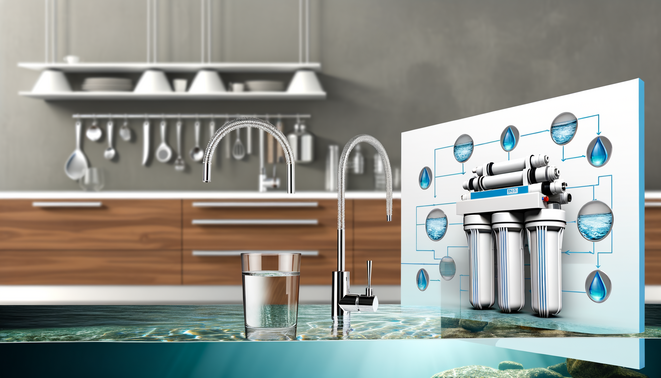“`html
Introduction to Reverse Osmosis
Reverse osmosis is a powerful water purification method that removes impurities from water through a special filter. This process is vital for ensuring clean, safe drinking water, impacting both health and environmental protection. Essentially, reverse osmosis operates by applying pressure to push water through a semipermeable membrane, filtering out harmful particles including salt, bacteria, and toxins. Standard reverse osmosis systems can reduce contaminants by up to 99% (Osmosis Info).
Access to clean water is crucial, as contaminated supplies can lead to numerous health issues stemming from harmful substances such as heavy metals. Studies have shown that households using reverse osmosis systems experience a noticeable decrease in health problems associated with water quality
.
The Science Behind Reverse Osmosis
The science of reverse osmosis is rooted in its unique membrane technology. This semipermeable membrane selectively allows certain particles to pass through while blocking larger contaminants. Pressure plays a pivotal role; when applied to the side of contaiminated water, it overcomes natural osmotic pressure, consequently letting pure water flow out while leaving impurities behind. Different systems utilize various membrane types, with thin-film composite membranes being the most popular for their efficiency and durability, removing up to 99% of contaminants (Osmosis Info).
Real-life instances highlight reverse osmosis benefits, as families employing these systems often report improved taste and quality of their water. Maintaining an understanding of RO system functionality also aids users in effective oversight and upkeep.
Benefits of Reverse Osmosis Water Filtration
Reverse osmosis offers numerous advantages. One of the primary benefits is its capacity to eliminate harmful substances, such as lead, chlorine, and fluoride. It effectively filters impurities from tap water, making it safer for consumption. Research indicates that RO systems can eliminate up to 99% of these harmful pollutants (Osmosis Info).
Moreover, reverse osmosis systems minimize microplastics in water, a growing concern linked to environmental pollution. They are generally easy to install and require minimal maintenance, as most systems only require filter changes every few months. Adopting an RO system also fosters environmental sustainability by reducing dependence on bottled water, thereby minimizing plastic waste.
- Removes harmful contaminants
- Improves water taste
- Eliminates microplastics
- Convenient installation
- Environmentally friendly
- Cost-effective long-term
Common Applications of Reverse Osmosis
Reverse osmosis technology has widespread applications in various domains including residential, commercial, and industrial settings. In homes, families often utilize under-sink or countertop RO systems to improve water safety and taste. In the commercial sector, restaurants and cafes heavily rely on RO to ensure high-quality water for cooking and beverages, significantly boosting customer satisfaction (Osmosis Info).
Industrially, sectors such as pharmaceuticals and manufacturing utilize RO for their high-purity water needs. Moreover, in agriculture, RO plays a role in irrigation, particularly in converting contaminated water into usable clean water.
Limitations and Considerations
While reverse osmosis systems provide effective water purification, they are not without limitations. A notable drawback is water wastage, with some systems wasting 3 to 5 gallons of water for every gallon produced. Additionally, RO can strip beneficial minerals from water, which may affect taste and long-term health. Some manufacturers offer remineralization options, which can help restore essential minerals to the water (Osmosis Info).
- Consider water waste generated by the system.
- Look for systems including remineralization features.
- Evaluate household water usage needs.
- Research efficient models that minimize waste.
Choosing the Right Reverse Osmosis System
Selecting the appropriate reverse osmosis system is critical for obtaining clean drinking water. Start by testing your water quality to identify contaminants present. Understanding your household’s water consumption is also important; larger families may require systems with higher production rates. Additionally, the type of system—whether under-sink, countertop, or whole house—matters. Maintenance costs associated with filter replacements should also be examined (Osmosis Info).
- Test your water quality.
- Assess daily water needs.
- Choose a system type that fits.
- Understand maintenance costs.
- Research warranties and support options.
Maintenance and Care for Reverse Osmosis Systems
Regular maintenance is crucial for the performance of reverse osmosis systems. Change filters every 6 to 12 months to ensure water purity, and sanitize the storage tank annually to prevent bacterial growth. Monitoring water pressure and checking for leaks can prevent more significant issues down the line. Additionally, aim to replace the RO membrane every 2 to 3 years to maintain system efficiency (Osmosis Info).
- Change filters regularly.
- Sanitize the tank annually.
- Check for leaks frequently.
- Monitor water quality.
Conclusion
Reverse osmosis plays an essential role in ensuring access to clean drinking water in today’s world, effectively filtering out impurities to improve safety and taste. Given the increasing pollution and scarcity of clean water, adopting advanced filtration technologies will be crucial for future water quality and accessibility. Staying informed about innovations in RO technology can enhance household water quality, contributing positively to health and environmental sustainability.
Sources
- Osmosis Info – Does RO Remove Microplastics from Water?
- Osmosis Info – GPD in RO: Meaning and Importance
- Osmosis Info – Master Your RO System: A Comprehensive Maintenance Guide
- Osmosis Info – Thin Film Composite RO Membrane Advantages
- Osmosis Info – Under Sink Reverse Osmosis System Basics
- Osmosis Info – Unlocking the Power of Reverse Osmosis: From Basics to Benefits
- Osmosis Info – Water Hardness Test Before RO Installation
- Osmosis Info – Thin Film Composite RO Membrane Advantages
“`

